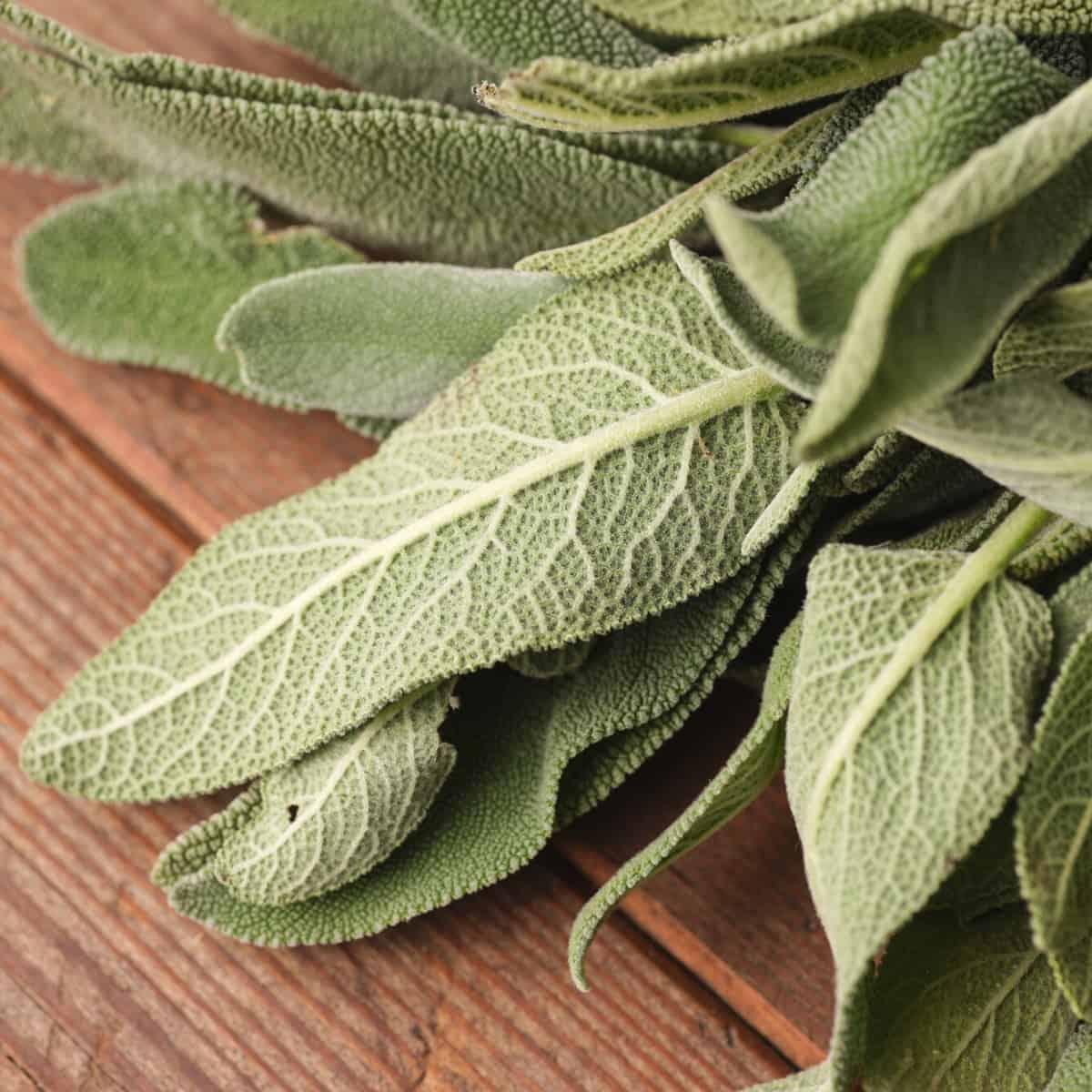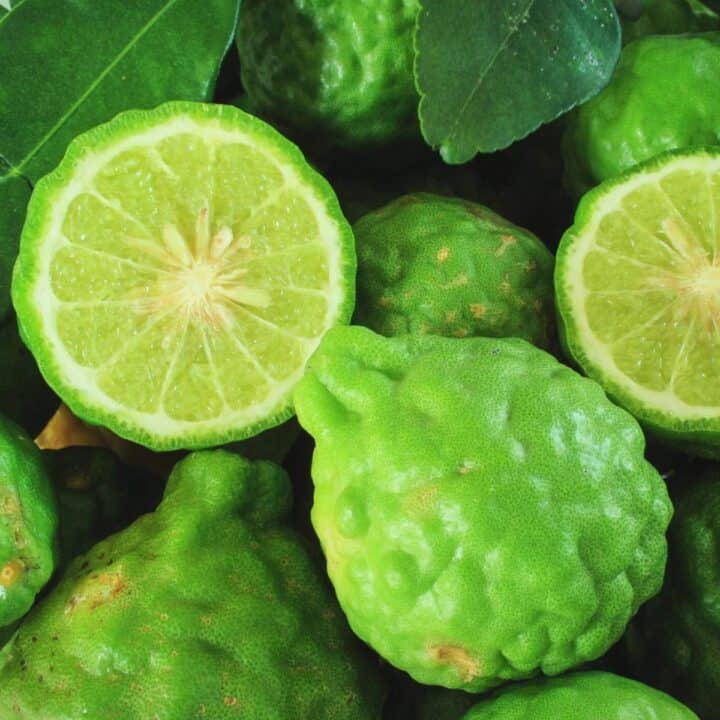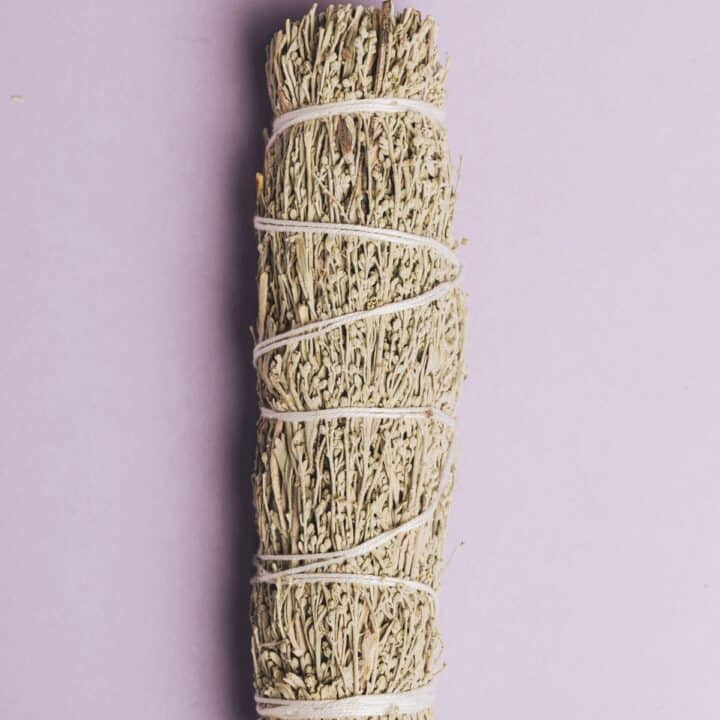What does sage smell like? Let's dive into the smell of sage, what it is, its different varieties and uses, and much, much more.

Sage is a well-known herb that has been used for centuries for its medicinal and culinary properties. Its scientific name is Salvia officinalis, and it is part of the mint family. Sage has a unique aroma that is both pleasant and distinct. In this article, we will explore what sage smells like, its origins, and some of its uses.
Jump to:
What is Sage?
Sage is a perennial herb that is a member of the mint family, that grows in the Mediterranean region, although it is now cultivated in many parts of the world. It has grayish-green leaves that are oval-shaped and covered in fine hairs. Sage can grow up to two feet tall and produces small, purple flowers in the summer. It is considered an evergreen shrub.
Sage has been used for centuries for medicinal and culinary purposes. The ancient Greeks and Romans believed that sage had healing properties and used it to treat various ailments. In medieval times, sage was considered a valuable commodity and was used as a preservative for meat.
What Does Sage Smell Like?
The delightful aroma of sage is released when the leaves are crushed or rubbed, and it can linger in the air for quite some time.
The aromas of different kinds of sage are often associated with feelings of relaxation and calmness. Sage is commonly used in aromatherapy to promote mental clarity, reduce stress and anxiety, and eliminate negative energy. Sage has also been found to have antimicrobial properties, making it a popular ingredient in natural cleaning products.
Sage comes in different varieties, each with its unique pleasant smell. Here are some common types of sage and their distinctive aromas:
- Common Sage (Salvia officinalis) - This is the most common type of sage used in cooking and aromatherapy, also known as culinary sage. It has a warm, earthy aroma, and herbaceous scent with notes of camphor and eucalyptus. Common sage is also known as garden sage and has gray-green leaves.
- Pineapple Sage (Salvia elegans) - The pineapple sage plant has a sweet smell and fruity fragrance that is reminiscent of pineapple. This variety of sage is often used in teas and desserts.
- Clary Sage (Salvia sclarea) - Clary sage has a musky, herbal aroma with notes of lavender and citrus. This variety of sage is often used in perfumes and aromatherapy.
- White Sage (Salvia apiana) - White sage has a pungent, very strong odor, that is often used in smudging ceremonies to purify and cleanse the air. It has silvery-white leaves and is native to California.
- Spanish Sage (Salvia lavandulifolia) - Spanish sage has a strong, herbal scent with notes of lavender and mint. This variety of sage is often used in perfumes and aromatherapy.
- Greek Sage (Salvia fruticosa) - Greek sage has a slightly bitter, herbaceous aroma with notes of lemon and mint, lending a rather unique fragrance. This variety of sage is often used in Mediterranean cuisine.
Each type of sage has its own unique scent and flavor, making it important to choose the right type for your intended use. Whether you're cooking with sage, using it in aromatherapy, or using it for its medicinal properties, understanding the differences between each variety can help you achieve the desired effect and further enjoy the different smells that sage provides.

Origins of the Word "Sage"
The word "sage" comes from the Latin word "salvare," which means "to heal." This is a testament to the herb's long history of medicinal use. In ancient times, sage was believed to have many healing properties and was used to treat a variety of ailments, including indigestion, sore throat, and insomnia.
Uses of Sage
Dried and fresh sage is commonly used in cooking, particularly in Mediterranean and Middle Eastern cuisine. It has a strong flavor that can be overpowering if used in large quantities, so it is often used sparingly. Sage is a popular ingredient in stuffing and is also used in soups, pesto, stews, and sauces.
Sage is also used in traditional medicine to treat a variety of conditions. It has been found to have anti-inflammatory properties, making it useful for treating conditions such as arthritis and asthma. Sage is also a natural antiseptic and can be used to treat wounds and cuts.
In aromatherapy, sage is often used to promote mental clarity and reduce stress. It is believed to have a calming effect on the nervous system and can help to improve concentration and focus. Sage is also a popular ingredient in natural cleaning products due to its antimicrobial properties.
How to Use Sage
The aromatic plant that is sage can be used in a variety of ways, depending on the desired effect. Here are some different ways to use sage:
Cooking: Sage can be used in a variety of dishes, including soups, stews, pesto, and sauces. This aromatic herb pairs well with roasted veggies, baked bread, poultry, pork, and lamb and is often used in stuffing for Thanksgiving turkey.
Tea: Sage tea is a popular herbal tea that is believed to have a calming effect on the nervous system, and for digestive disorders, among other medicinal purposes. To make sage tea, steep fresh or dried sage leaves in hot water for several minutes.
Aromatherapy: Sage essential oil can be used in aromatherapy products to promote mental clarity, prevent memory loss, and reduce stress. Add a few drops of sage oil to a diffuser or mix with a carrier oil to use in a massage.
Cleaning: Sage is a great option for natural cleaning products due to its antimicrobial properties and the belief that it helps cleanse negative energies as well. Add a few drops of sage essential oil to a spray bottle filled with water and use it as a natural disinfectant.
Burning: Some varieties of sage, especially dry white sage leaves, can be used for smudging purposes and cleansing a space through its smoke when burned, as has been done for centuries by indigenous peoples in spiritual practice around the world. Head on over to our guide for burning sage to learn more.

In Conclusion
In conclusion, sage is a versatile and powerful herb that has been used for centuries for its medicinal, culinary, and spiritual properties. Its distinctive aroma, which can vary depending on the variety of sage, is often described as warm, earthy, and slightly sweet. Sage is commonly used in cooking, aromatherapy, and smudging ceremonies.
Understanding the different types of sage and their unique scents and flavors is essential to using this herb effectively. Whether you're cooking with sage to add depth and flavor to your dishes, using it in aromatherapy to promote relaxation and mental clarity, or smudging with sage to purify and cleanse the air, there are many ways to incorporate this powerful herb into your daily life.
As with any herb or plant, it's important to use sage responsibly and with respect. If you have any medical conditions or are pregnant, consult with a healthcare professional before using sage. With proper care and attention, sage can be a valuable addition to your holistic health and wellness routine.







Comments
No Comments